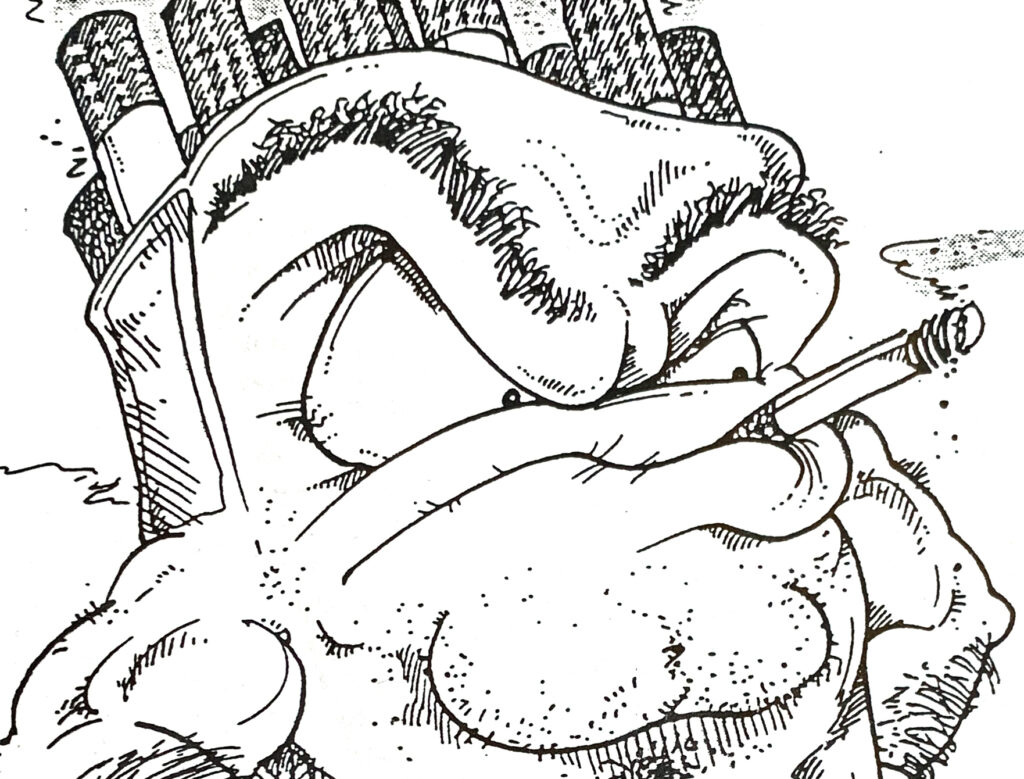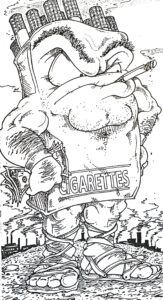First published in the Spring 1993 issue of Priorities magazine, pp. 20-23.

By Kevin C. Goebel
Lodi, a conservative, rural community in Northern California with a population of about 46,000, was hardly a likely candidate to set health trends. But in June 1990, shortly before the city council was scheduled to consider an ordinance restricting smoking, the Environmental Protection Agency released a draft risk assessment of environmental tobacco smoke (ETS). The draft report classified ETS as a Group A Carcinogen, officially ranking it, for the first time, among a handful of toxins definitively known to cause cancer in humans.

In response, the council strengthened the proposed ordinance, and Lodi became one of a few California cities to eliminate completely smoking in restaurants. The ordinance sparked a new trend in local smoking restrictions. Rather than simply restricting smoking to separate areas workplaces and other public places, as over 500 local ordinances have done since the 1970s, many of the newest ordinances completely eliminate smoking Lodi’s ordinance posed a new threat to the tobacco industry. If the older ordinances threatened industry profits (by reducing cigarette consumption and creating an environment where public smoking was neither convenient nor socially acceptable, thereby encouraging smokers to quit), the new, smokefree ordinances were even worse.

Before Lodi, only a few communities in the U.S. had eliminated smoking in either restaurants or workplaces. Lodi’s ordinance, however, was the first to receive national media attention. Both the tobacco industry and tobacco control advocates knew that the success of Lodi’s ordinance would trigger a chain reaction throughout the nation.
The industry pulled out all the stops to block the new wave of ordinances. The following strategies, developed over more than a decade of battling the nonsmokers’ rights movement, were all used in Lodi, and most were used in the other communities that considered smokefree ordinances.
Buying Politicians
The tobacco industry has profited for decades from a legalized form of bribery: campaign contributions. By June 1992, the tobacco industry had contributed $578,390 to U.S. Senators for the 1991-92 election cycle, and over $1 million to the top 20 recipients in the House of Representatives for the same period, placing the tobacco industry among the most generous contributors. At the same time, tobacco industry contributions reached $1.34 million to the Republican National Committee and $731,000 to the Democratic National Committee.
The money flows equally freely in state legislatures. During the first 18 months of the 1991-92 election cycle, the tobacco industry contributed S741,450 to state legislators in California. Other states reported similar contributions.
Tobacco companies would not make these contributions nor entertain politicians if they did not receive something in return. In an internal report leaked to DOC (Doctors Ought to Care), a Philip Morris lobbyist described the effectiveness of spending money on politicians. “We continue to give to the various [political] caucuses and they will continue to be of service to us,” the lobbyist explained, adding, “This type of contribution does buy political clout.”
And how can they be sure it buys the clout they want? The lobbyist explains, “The same guys I took to the race- rack in Oklahoma and hunting last year were the very ones that helped us hold the leadership firm on no cigarette taxes.”
With these contributions, the tobacco industry is able to defeat almost every significant state or federal bill introduced to protect nonsmokers. In larger cities like Los Angeles and San Francisco, campaign contributions are also an effective part of an overall campaign against smokefree ordinances. In most local communities, how- ever, elections are far less costly and significant contributions from the industry are not as common. As a result., the industry disguises its influence locally and uses other strategies to oppose local ordinances.
Synthetic Grass Roots
The tobacco industry has always envied the nonsmokers’ rights movement’s grass roots power. Voters tend to have a better sense of what is happening in City Hall than in state legislatures or Washington, DC. They are closer to council members and are more likely to gain access to them. As a result, constituent support for local smokefree ordinances very often outweighs tobacco industry muscle.
Because the industry has no credibility locally, it tries to keep a low profile. The tobacco companies have created a synthetic grass roots movement designed to foster the illusion of a fight between smokers and nonsmokers, rather than health advocates against a multibillion dollar, multinational industry.
To create this illusion, the tobacco industry often con- ducts direct mail programs designed to develop mailing lists of smokers who might be interested in fighting on the industry’s behalf. Coupons redeemed for cigarettes are one of the most obvious examples of how the industry develops these databases.
Names and addresses are then used by the industry to alert smokers about pending legislation in their area. Philip Morris, R.J. Reynolds, Brown & Williamson and The Tobacco Institute all have programs designed to teach smokers how to write letters, make telephone calls and engage in other activities to defeat smokefree ordinances.
Of course, the tobacco industry knows that most smokers do not oppose smokefree ordinances. A 1987 Gallop poll conducted for the National Restaurant Association found that 29 percent of smokers preferred to sit in the nonsmoking section of restaurants, 1992 California poll found that 67 percent of smokers indicated that it was “not at all important” to then to be able to smoke when they dine out. As a result, the industry tries not to rely on local smokers to oppose smokefree ordinances.
Instead, state and local restaurant associations, Chambers of Commerce and individual businesses, are provided with tobacco industry materials and arguments and, on occasion, even financial resources, to do the tobacco industry’s dirty work. Recipients of tobacco industry charitable contributions also asked to defend the industry. In New York City, the Coalition for the Homeless, which once received $100,000 from Philip Morris, was asked to write to the City Council against a proposed ordinance mandating anti-tobacco advertising, The Coalition refused, and now refuses tobacco industry contributions.
This strategy is becoming increasingly ineffective as more and more businesses recognize that smokefree ordinances are sensible from both a health and an economic perspective. Legitimate organizations have their own agenda that does not always coincide with the tobacco industry’s, and the industry cannot always count on their support.
The industry, therefore, uses public relations and political consulting firms to create “front groups” that have the illusion of being a coalition of local busi- nesses or smokers. The California Business and Restaurant Alliance (CBRA), one of the most active of these groups, was created by the Dolphin Media Group, a public relations firm which lists Philip Morris as one of its most prominent clients. CBRA now admits that they receive funding from the tobacco industry. Dozens of similar groups exist throughout the country.
These front groups are instructed to deny the tobacco industry’s involvement. “Reynolds is to be kept out of it. The media are to be told that smokers have formed their own group and would go to the wall for their right to puff, explained Ralph Jennings, a reporter with WOAI radio in San Antonio, TX, who infiltrated a smokers’ rights training program organized by R.J. Reynolds in 1989.
Since these front groups cannot use campaign contributions to influence council members, they are forced to wage campaigns of deception – perhaps the most common tobacco industry trick.
Telling Lies
It comes as no surprise that an industry willing to profit by killing its own customers would completely disregard the truth. Inflammatory rhetoric, misleading statements and outright false- hoods are the tobacco industry’s political bread and butter.
In Madison, WI, tobacco industry and tavern lobbyists clouded the issue by successfully arguing that a proposed smokefree restaurant ordinance would hurt business in bars – even though bars were specifically exempt from the ordinance. In New York City, the tobacco industry claimed that their own polls showed that the vast majority of New Yorkers opposed a proposed smoking control ordinance. It was later discovered that the poll distorted the ordinance’s provisions.
In Sacramento County, CA, opponents of a smokefree ordinance focused their campaign on the problems of draconian “smoking police.” In fact, the ordinance is enforced on a complaint basis by the county health department. Police are never used.
In addition to misleading residents about the actual provisions of smoke- free ordinances, the tobacco industry lies about their impact. Their studies, which, not surprisingly, are scientifically flawed, suggest that smokefree ordinances will hurt business in restaurants.
Only one study conducted by the University of California, San Francisco considers all of the different factors needed to evaluate properly an ordinance’s impact. The report found that none of the cities
studied suffered economically from smokefree ordinances. In fact, the restaurants in the cities that had been studied became slightly more competitive, drawing a larger percent of retail sales than before the ordinance passed or than neighboring cities without smokefree ordinances.
“It’s Not Over Til It’s Over”
The tobacco industry’s opposition to a smokefree ordinance does not end with its passage. The industry has developed a strategy of undermining ordinances in hopes of later repealing them.
The industry sometimes pavs professional signature-gatherers to place the ordinance on the ballot as a referendum. In 1990, the industry attempted but failed to repeal Lodi’s ordinance by putting it on the ballot. Since then, despite repeated attempts, only one ordinance has been overturned by this process. In November 1992, voters in five communities – Flagstaff, Ariona, and Chico, Sonoma, Butte and Shasta County, CA – considered smokefree restaurant ordinances. Every community voted to go smokefree, with the margin of victory averaging 21 percent.
Given their failures at the ballot box, the tobacco industry may consider dropping this tactic, as they did after their failures in the early 1980s. However, activists cannot rest easy. The tobacco industry may return, some- times more than a year after the ordinance is enacted, to try to repeal it. Newly-elected council members sometimes provide the change the industry wants. In an internal Tobacco Institute memo, Kurt Malmgren, Senior Vice President of State Activities, wrote, “The change in the City Council (in Paradise, CA) gives us another opportunity to appeal to the new Council for a compromise to the ban.”
This strategy worked well in Bellflower, CA, where two new council members succeeded in repealing the city’s smokefree ordinance at their first council meeting. Some residents later complained that if they knew these candidates opposed the ordinance, they would never have voted for the two.
The tobacco industry will often threaten council members with a recall campaign if they support the ordinance. Rarely, however, is this threat carried out. In over 540 communities with smoking control ordinances, recall efforts have been attempted only a few times. In 1989, in the clearest example of a recall attempt that was definitively linked to smoking control legislation, the tobacco industry attempted to recall Councilman Richard Chapman of Albuquerque, NM, sponsor of a nonsmoking ordinance. Chapman prevailed by a three to one margin.
Although the tobacco industry often argues that smokefree ordinances are unconstitutional, it will almost never take the case to court. When a local restaurant tried to overturn Lodi’s ordinance in court, the city won at both the trial and appellate levels. In fact, rhetoric notwithstanding, the tobacco industry has never mounted a serious legal challenge to a smokefree ordinance, perhaps fearing that a precedent against it would undermine its arguments.
Preemption
The tobacco industry’s opposition to local smoking restrictions is not limited to local communities. If the tobacco industry can’t win before a city council – and it usually can’t – the tobacco industry will turn to its allies in state legislatures to strip local communities of the power to regulate smoking
Preemptive state laws have been the cornerstone of the tobacco industry’s strategy since 1985. Eight states have adopted preemptive laws, which are invariably weaker than local laws and impossible to enforce. Many nonsmokers’ rights advocates, therefore, adopt a strategy of working at the state level primarily to defeat bad bills supported by the industry, while working locally a to protect nonsmokers.
Looking to the Future
The passage of smoke free ordinances continues to escalate dramatically. By the end of 1992, 51 communities eliminated smoking in restaurants, workplaces or both. In the first few weeks of 1993, another four communities joined them. Although California’s deluge of smokefree ordinances officially began in 1990, smokefree ordinances have spread to Colorado (which quietly preceded California), Arizona, Massachusetts and Wisconsin. Communities in several other states are also considering smokefree ordinances.
The official release in January of the Environmental Protection Agency’s final risk assessment on ETS – whose first draft prompted Lodi’s landmark ordinance – has undoubtedly fueled these efforts. As these ordinances spread, the tobacco industry will be forced to devote more resources to defeating, repealing or preempting these laws… or risk going out of business.
Kevin Goebel is the Manager of Legislative Programs for Americans for Nonsmokers’ Rights, a national nonprofit advocacy group dedicated to protecting nonsmokers by passing legislation restricting smoking.
Spring 1993
